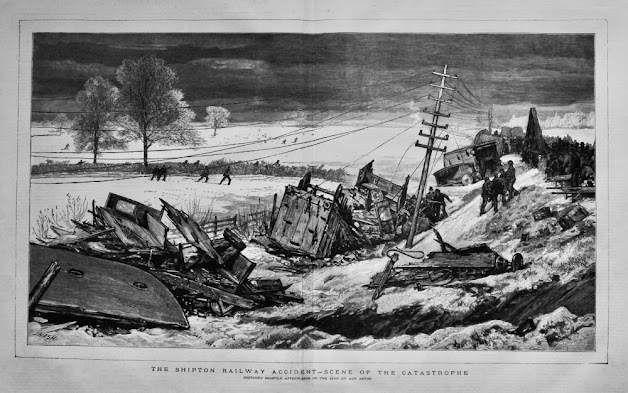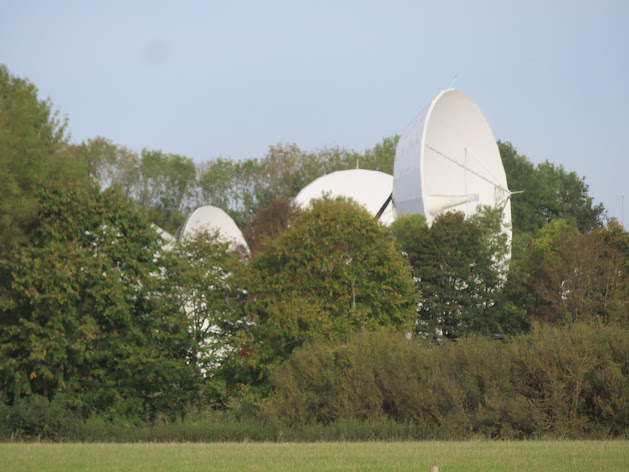Sorry we are a bit late with this blog we moored up with insufficient signal.
We were toasty through the night but when I got up to make the tea there was a frost and 'smoke on the water'.
We were a little late setting off and as Helen was ashore lifting the bridge and nobody was on the facilities, we went to top up the water. I had had a message regarding the closure of Kidlington Green Lock after a boat strike broke the beam? Luckily we are the right side of it. A lady at the water point told us that Baker's Lock that pens up into the Cherwell was on red boards, but we felt that traffic would have been backing up at Thrupp if that was the case and continued on our way.
As we cleared Thrupp we came to the railway line that crosses the canal, close to where the Woodstock railway joined. On Christmas Eve in 1874 this was the scene of a terrible rail accident. The 10 am London Paddington train bound north to Birkenhead was packed for the holiday. It had 14 carriages behind the engine and due to traffic and passenger delays at Reading it was running 15 mins late. When it got to Oxford they decided to added another carriage to the train, and to ensure that they didn't fall any further behind than necessary they also added another engine. At sometime between 12 and 1 pm the train was making 40 mph as it approached the bridge over the River Cherwell near Thrupp. Something went wrong and a Great Western Railway employee lent out of the window and waved. Apparently this was the emergency signal to the engine. Other reports state that he put his arm out of the window to pull the emergency wire that was external and rang a gong in the engine. The man remembers hearing the answering whistle from the engine, but nothing else. The driver applied the brakes and whistled again for the brake van at the rear of the train to apply his brakes. It was never heard. It was found after the accident that one of the wheels on the first carriage shed its 'tyre'. The was the circular bit that had contact with the rails and in those days there were different types. These were attached to the wheel by four rivets and it seems three of these gave way. The weather was very cold with snow everywhere and it was conjectured whether this and the heavy load may have had something to do with them giving way. The carriage continued to run straight, crossing the river bridge but slid over and off the embankment dragging the next few with it.
As the train sped on the chains connecting some of the carriages broke and the next few carriages continued on until hitting the rear of the engines that had slowed and then rolling down the embankment at the canal bridge. At the rear of the train some carriages stayed on the tracks and there was relatively little damage. Many were on the scene and the news got back to Oxford very quickly via the signal boxes and rescues set off very quickly.
One little girls was found in the canal. She was too young to talk and it was assumed that her family had died. She was taken to the Boat Inn at Thrupp to be looked after. Bodies that were recovered were taken to the paper mill by the river at Hampton Gay close to the scene. Within an hour the section of the canal had been drained to assist in the search and rescue. In the end it was found that 34 were dead, mainly from the first few carriages, 26 in the accident and 8 from injuries received. There were also 69 seriously injured passengers too. The little girl was found to be travelling with her mother and older sister and her father claimed her a day later.
At the inquiry it was found that it was caused by the shedding of the tyre that caused the derailment. It was recommended that GWR should resort to the wooden wheels with a trim on as they had a better safety record. This problem was the cause of many accidents over the years until they managed to manufacture a steel casting of the wheels in one piece. They also recommended that there should be better communication cords and that there should be some system of breaking across all elements of the train, not just the engine and the brake van. Soon after the vacuum brake was introduced.
When we got to Shipton Weir Lock we could see that the strong stream warning board was in amber and off we went, as had everybody else who had passed us that morning.
Helen was patiently waiting for the lock to fill.The rise was small, but as it is a diamond shaped lock there was a fair bit of water to come in, and only one paddle at each end.
The river section is quite short, but there are several bends. It was easy going against the current but with the flow behind it could make life interesting, but it wasn't running that fast really.
As we approached Baker's Lock at the end of the river section we could so the dishes of a satellite earth station. This one in a disused quarry at Whitehill is run by Mercury and transmits signals to satellites that are then transmitted to other stations around the world as part of the telephone system.
Just at the head of Pigeons Lock, that was named after the Three Pigeons pub that was by the bottom gates, is Flights Mill. This was built in the 18th Century and had an undershot water wheel. In 1903 it was for sale with a three story house and corn mill with two stones. It was derelict in 1968 and the milling equipment removed. It was later rebuilt as a residential property and the 13' x 5' water wheel now drives a generator. It was last sold for £1.7 million and is valued today at £2.4 million!
Not much sun today, but very little wind, so very pleasant cruising, meeting the odd boat as we go along.
This area has many disused quarries. The main one, with the moorings by it, is Kirtlington Quarry. This is an SSSI and was formed 166 million years ago when it was a barrier island in a coastal location, much like the Florida Keys today. This was the Jurrasic time and the limestone and clay deposits are full of very notable fossil groups here. Dinosaurs such as cetiosaurus, 15m long, megalosaurs, pterasurs and sharks and long nosed crocodiles. How ever they are noted for the mammalian fossils that are found there. From 1907 to 1928 the rock was used for cement production. This photo is of another part of the same quarry closer to Pigeon's Lock.
Along the length of canal between Dashwoods Lock, (Named after the family that owned Kirtlington and Northbrook from 1641 to 1909), and Lower Heyford, along the stretch of The Cleeves Woods, we saw four or five kingfisher, but only managed to get this half decent shot of one.
We stopped before getting to Upper Heyford and then managed to wash the port side, even Helen helped today.












No comments:
Post a Comment